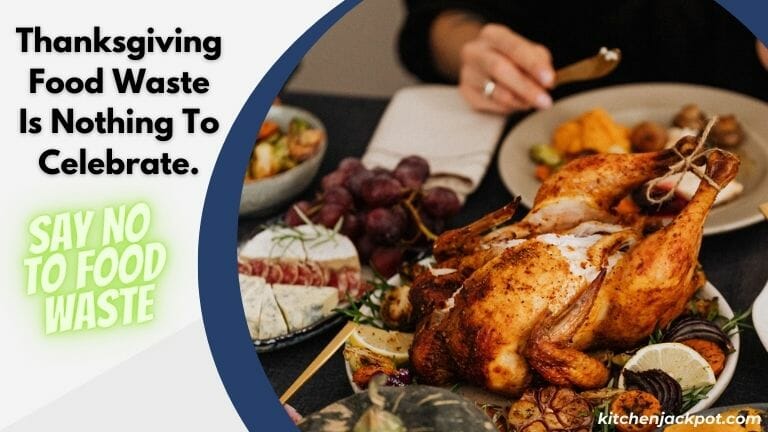
This Thanksgiving, Americans will stuff themselves silly, watch football that has nothing to do with the World Cup, take a nap—and then try to figure out what to do with all their leftovers. So sadly, there will be a lot of it that will not be eaten.
But there are ways to ensure that your leftovers don’t go to waste. One way is to freeze them so you can enjoy them later. Another way is to give them away to friends or family who might want them.
Whatever you do, don’t let your Thanksgiving leftovers go to waste!
According to a recent estimate from ReFED, an organization based in New York that researches food waste, American households will waste approximately 305 million pounds of food this holiday season.
That comes out to nearly a pound per person and is almost triple the 115 million pounds of residential food wasted daily on average.
However, because food waste is not distributed evenly, ReFed points out that a more accurate way to think about this amount is that it would provide 6.5 meals to each of the 38.3 million people in the country who are food insecure.
Key cooking appliances are the heart of any functional kitchen. These essential tools make the culinary journey more efficient and enjoyable. Explore our guide on “Key cooking appliances” to discover their significance and how to choose the best ones for your kitchen.

Food waste isn’t just a humanitarian concern. It’s also an environmental one. From the farm to the dinner table, Thanksgiving food waste creates nearly 1.1 million metric tons of carbon dioxide.
That’s the same emissions output as 170,000 cars driving for a year. However, that’s just the start. All that unwanted food and orphaned slices of pumpkin pie will likely produce additional greenhouse gas emissions when they decompose in landfills or get incinerated.
Food scraps that end up in composters, anaerobic digesters, animal feed, or other more environmentally friendly destinations aren’t considered waste by ReFED’s analysis.
According to Jackie Suggitt, director of capital, innovation, and engagement at ReFED, “Culturally, Thanksgiving is about abundance and so traditional food-management skills that consumers have to go out the window.”
This holiday tends to lead to more waste because people are cooking new foods, hosting guests that they don’t usually feed, and cooking more than they need to in order to avoid running out of food.
Suggitt recommends being mindful of these tendencies in order to reduce the amount of food waste this holiday season.
You’ll learn how to be more grateful for what you have and how to reduce your food waste during the holiday.
Americans waste billions of dollars worth of food every year. In fact, according to the United States Department of Agriculture, we waste as much food each year as the rest of the world combined.
Approximately 54 million tons of solid waste were generated in the United States in 2006. About 39% of that was collected from residential sources.
That’s a huge percentage of waste — as the below graph shows. But waste accumulates in each stage of the supply chain, from the farm 27% to the store 7%.
Households are, however, the main contributor to greenhouse gas emissions from uneaten food.
Contents
Best Tips For Thanksgiving Tradition:
We don’t want to ruin your favorite Thanksgiving tradition, but we thought it would be a good idea to share some simple ways to reduce food waste and emissions this holiday season. Here are a few practical tips:
- Make a plan before you start cooking. Know how many people you’ll be feeding and what dishes they’ll want. This will make it easier to avoid making too much food.
- Savethefood.com’s Guest-imator tool is the best way to figure out how much food you’ll need for your event! Just select the types of dishes you’ll be serving and enter the number of guests, and the Guest-imator will give you an estimate of how much of each dish you’ll need to prepare.
- Use leftovers in creative ways. There are tons of recipes online for Thanksgiving leftovers. Get creative and see what you can come up with!
Compost any food that you can’t eat. This will help reduce emissions from landfills. Thanksgiving is a time to be thankful for what we have. Let’s not waste it! - Once the meal is over, the planning begins again. After a few days, leftover turkey sandwiches lose their appeal.
That’s why, Suggitt says, it’s helpful to creatively reinvent the leftovers—like making a turkey soup or topping a shepherd’s pie with the remaining mashed potatoes.
Freezing foods is a great way to preserve the freshness of many dishes, says Suggitt. But it might take a little Google magic to determine if there is a special technique to thaw a frozen food so that the texture and the experience of eating that food are retained.
If you are looking for information about how freezing food can be cooked properly by an air fryer then read this article about how to Pre-air fryer defrosting.
Conclusion: (Thanksgiving Food Waste Is Nothing To Celebrate)
In conclusion, this year, try to go beyond the obvious. Instead of focusing on food waste, think about the ways that you can do your part to help the environment. For example, if you’re hosting a large gathering, try to find a local farm or farmers market that you can buy from.
If you’re cooking at home, make sure you’re using the leftovers to make a new dish. If you’re serving your meal, consider composting your scraps. And, if you’re giving a gift, think about a reusable container instead of a plastic one.